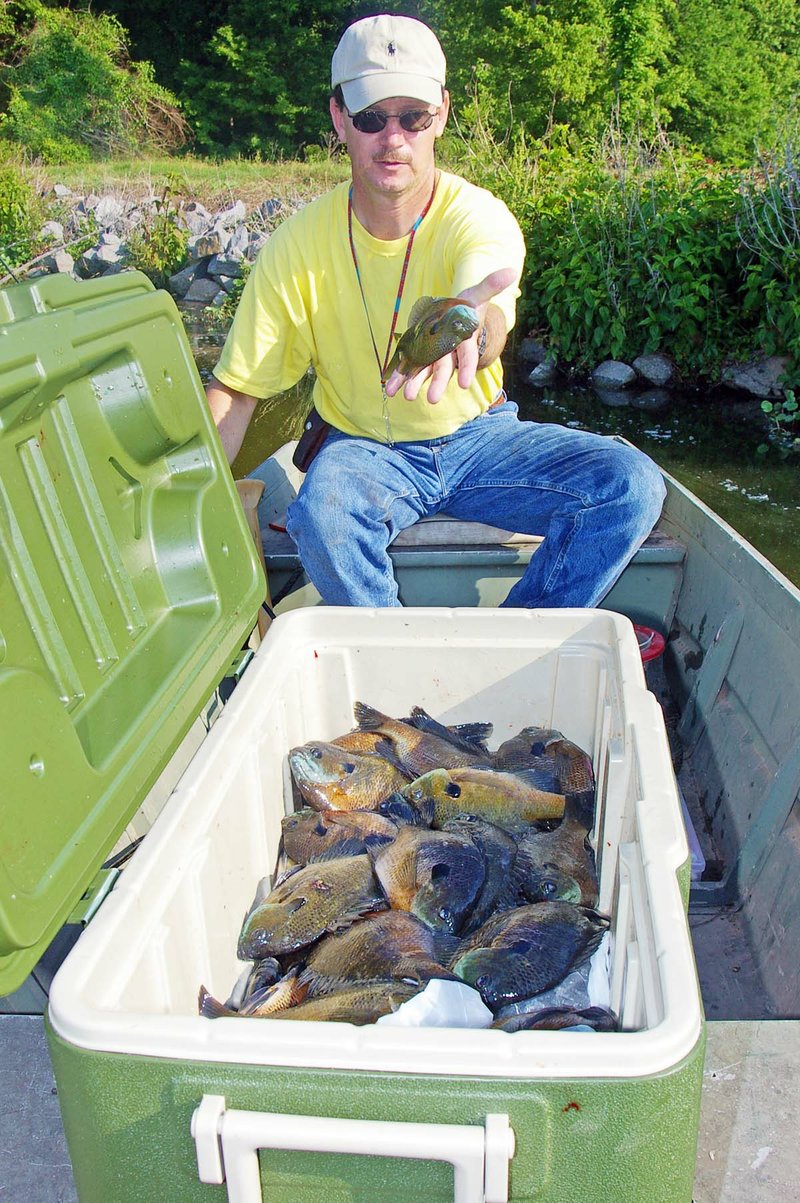It was a day of bream fishing I’ll never forget. My best friend, Lewis Peeler, and I had launched our boat into Mallard Pond, one of the beautiful cypress lakes in east Arkansas’ Henry Gray/Hurricane Lake Wildlife Management Area. We quickly rigged two ultralight spinning combos, baited our hooks with crickets and were ready to fish. By the time I made my first cast, Lew was already reeling in his second dandy bluegill.
“It’s gonna be a great day for bream fishing,” he said, putting the big black fish in our fish basket.
I was now playing my own fish, and soon it, too, was added to the basket. Lew caught another, then me, then him, and so on and so on. Three hours later, we were ready to head home with two 50-fish limits of bluegills and redears. I snapped a shot of Lew standing on the front of the boat holding the long stringer of fish, an exceptional catch in anyone’s book.
During May and June, Arkansas bream fishing can be like that. The fish are on their spawning beds, and catching them is easy. Just flip a cricket, worm, jig or popping bug by shoreline cover, and get ready for action.
Here are three good places to try.
Henry Gray/Hurricane Lake WMA Lakes
As the story above shows, Henry Gray/Hurricane Lake WMA encompasses some of Arkansas’ top bream-fishing hot spots. In fact, within the management area are eight easily accessible oxbow lakes harboring healthy populations of bluegills, redears, warmouths (goggle-eyes) and other bream. Big Hurricane Lake is largest at 60 acres, followed by Whirl Lake (30 acres), Mallard Pond (18 acres), Big Bell Lake (16 acres), Honey Lake (16 acres), then Bollie Pond, Three Sisters Lake and Little Green Tom, each between 5 and 10 acres in size. All these waters have cypress and tupelo trees towering over the shallows. Just cast near one of the trees, and bingo! Fish on.
Local anglers use a wide variety of baits when targeting these scrappy sportfish, including live worms and crickets, and lures such as small jigs, flies, poppers and tiny topwater plugs. It’s not unusual to catch 100 or more bream on a single outing in May or June.
WMA signs on U.S. 64, 5 miles east of Bald Knob, direct traffic south onto a paved road leading 3.2 miles to the WMA’s main entrance. Gravel WMA roads lead to the lakes. For additional information and an area map, visit www.agfc.com. Click on Hunting, Where to Hunt, then White County.
Lake Ouachita, Arkansas
Surrounded by the Ouachita National Forest, 40,000-acre Lake Ouachita in west-central Arkansas is known for its scenic natural beauty and the clarity of its waters. Named one of the cleanest lakes in America, this beautiful U.S. Army Corps of Engineers impoundment is a water sports mecca for swimming, skiing, scuba diving, boating and fishing. And the bream fishing here is best described in terms of temperature; it’s HOT! Ouachita harbors an extremely healthy population of bluegills a pound and up, and anglers in the know will catch plenty of huge redear sunfish as well. Both species can usually be found in quiet coves along the lake’s 975 miles of shoreline or in deep weed beds surrounding the lake’s many islands. When fishing the latter, remember that big bream usually hold near weed-bed edges, so pinpointing the perimeter is important. Cast too far, and you get snagged. Try to place bait so it falls right at the edge.
Scout from a boat first, wearing polarized sunglasses to cut glare and help you see the weed beds. The lake is exceptionally clear, so it’s easy to see concentrations
of bream.
Standard bream-fishing gear is an ultralight combo spooled with 4- to 6-pound line, a cage full of crickets, a couple boxes of worms and a cooler of drinks.
Located just a short drive from the spa city of Hot Springs on the lake’s eastern shore, Lake Ouachita State Park is a good place to call “home away from home” when visiting this popular bream-fishing lake. The park’s fully equipped cabins include seven that overlook the lake and one that offers a woods view. There are 103 campsites as well, plus picnic areas, trails, a swimming area and a marina with boat rentals, bait and supplies. The visitor center includes exhibits and a store.
To reach the park from Hot Springs, travel 3 miles west on U.S. 270, then 12 miles north on Arkansas 227. The address is 5451 Mountain Pine Road in Mountain Pine. Additional information is available by calling the park at (501) 767-9366 or visiting www.arkansasstateparks.com/lakeouachita.
Lake Atkins
Lake Atkins sits in the fertile Arkansas River Valley just south of its namesake town in southeastern Pope County. Covering 752 acres, the lake has long been considered one of the best bream lakes in this part of the state. Lunker largemouths, crappie and catfish compete for the angler’s attention as well, but Atkins’ main drawing card is its burgeoning population of jumbo bluegills and redear sunfish. One Arkansas Game and Fish Commission creel survey found these were the species most fished for, accounting for 53 percent of visiting anglers’ fishing time. The 852 fishermen interviewed on the lake had caught 25,490 bluegills and redears, an average of 30 apiece.
Live crickets are the preferred bait for enticing the lake’s 3/4- to 1-pound bluegills. Redears, which sometimes reach 1 1/2 pounds, favor live worms fished on the bottom. Both species are usually taken around cypress trees, dead timber, willows, buckbrush and weed beds.
Access to the lake is excellent. Turn south at the Atkins exit (exit 94) on Interstate 40 to Arkansas 324 or 105. Both highways lead to access roads marked by signs. Boaters can launch at any of seven ramps. Bank-fishing facilities include four fishing jetties and two wheelchair-accessible fishing piers. For more information, including an excellent lake map, go to www.agfc.com, then click on Fishing and Boating, Where to Fish and Pope County.
